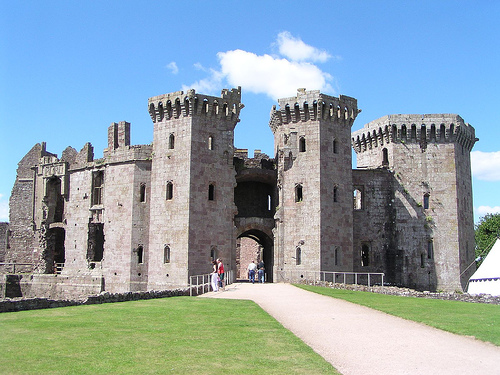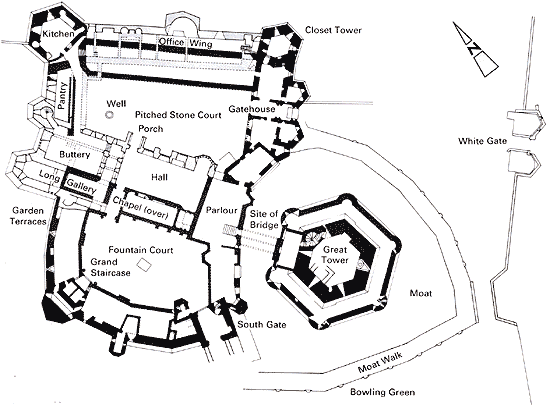

Location: Monmouthshire County, Wales Map
Raglan Castle (Welsh: Castell Rhaglan) is a ruined castle in Monmouthshire, Wales. Classified as a Grade I cultural monument and protected as a Scheduled Monument, the ruin lies north of the village of Raglan. Built in the 15th century, the castle was one of the last fortifications built as a castle in Great Britain, but it also served as a representative status symbol from the start.

Medieval origin and expansion under William ap Thomas
A motte
with earth and timber fortifications was probably built on the site
of the present castle during the Norman conquest of Gwent. It was
later converted into a medieval manor house inhabited by the Bloet
family. William ap Thomas, a member of the gentry, had married
Elizabeth Bloet, widow of James Berkeley, around 1406. His wife died
in 1420, and William received permission from his stepson, James
Berkeley, to keep Raglan for life. In 1432 he bought the castle from
his stepson. William, now prosperous and powerful, had most of the
old mansion demolished and began building a magnificent castle. The
southern gate, the mighty keep and the hall wing come from him. The
complex was surrounded by a ring wall, which was probably still part
of the old manor house.
Expansion under William Herbert
After his death in 1445, his ambitious son William Herbert took over
the castle. He was the leading supporter of Richard of York in Wales
during the Wars of the Roses. Herbert was also guardian of the young
Henry Tudor, later King Henry VII, who therefore spent part of his
childhood at Raglan Castle[3] until Herbert was executed in 1469
after the lost Battle of Edgecote Moor. Herbert used his wealth to
expand Raglan Castle and expand it to its current size. He built the
fortress-palace around two inner courtyards and built the large
gatehouse on the south-west facade instead of the southern
gatehouse. The building was probably completed when he died, his son
William only had the interior work completed.
Castle-like
expansion under the Earls of Worcester
The daughter and heiress
of the 2nd Earl of Pembroke, Elizabeth Herbert married Charles
Somerset in 1492, an illegitimate son of Henry Beaufort, 3rd Duke of
Somerset, who was made Earl of Worcester in 1514. After the 3rd Earl
of Worcester inherited the castle in 1549, he had the castle rebuilt
in the Tudor style. During his reconstruction he retained the
fortified exterior and the previous architectural style, but he used
a more reddish sandstone for his buildings. He rebuilt the east side
of the hall, extended the hall wing and created the Long Gallery on
the upper floor, which ran the entire length of the hall wing. He
also rebuilt the north-west and north-east wings of the outer
courtyard and laid out terraced gardens around the castle and a
large lake to the north-west of the castle. The 4th Earl of
Worcester also had some alterations made around 1600, he built the
passage around the keep's moat.
Destruction during the
English Civil War
The 5th Earl, who inherited the castle in 1628,
was made Marquess of Worcester in 1642, but he paid a heavy price
for his loyalty to the king. The castle became the last royalist
bastion in South Wales during the Civil War and in 1645 King Charles
I took refuge here for several weeks. In 1646 the castle saw its
only military action when a Parliamentary army under Fairfax
besieged it. Although the Marquess had earthworks built to defend
the castle to the east and south, after a thirteen-week siege and
heavy mortar fire, the garrison had to surrender to the opposing
forces on August 19, 1646. The castle was badly damaged during the
siege, and Parliament's troops then razed the castle's
fortifications. The keep and other parts of the castle were
destroyed in the process, and the victors also had the famous
library of Welsh writings, founded by William ap Thomas, destroyed.
After the restoration of the monarchy, the 3rd Marquess of Worcester
used Badminton House in Gloucestershire as his new home, replacing
the ruined Raglan. The ruins served as a quarry and became a tourist
attraction as early as the late 18th century. It was given to the
state by the 10th Duke of Beaufort in 1938 and is now managed by
Cadw.
The ruin sits on a commanding hill in the hill country of central Gwent. Access is through the 16th-century outer White Gate, flanked by the ruins of two pavilions. Nothing remains of the original Norman castle and medieval manor house, although the Great Tower and inner Fountain Court are thought to follow the layout of the medieval Motte and Bailey complex. The castle is built around two courtyards, with the keep outside the two courtyards and to the left of the main gate. The 15th century buildings were all very carefully carved from Wye Valley sandstone. Brick was used in the interior of the castle, particularly the vaults, making the castle one of the earliest structures in Wales to use brick in its construction.
The mighty keep is south of the two castle courtyards and could be defended independently. The hexagonal plan, unusual for English and Welsh castles, was probably influenced by French castles encountered by builder William ap Thomas during the campaigns in France. The mighty tower served as a status symbol for the wealth and position of its builder and is surrounded by its own moat. William Herbert also had the low, hexagonal wall built around the tower. The outer gallery around the ditch was probably laid out around 1600 as a footpath. Access to the keep was originally via a wooden bridge and two drawbridges from the main bailey, which was later replaced by a stone bridge. Originally, the tower had five floors and was crowned with a battlement with machicolations, the 3 m thick walls were supposed to withstand artillery fire and even had loopholes for artillery on the ground floor. During the razing of the castle, the two eastern sides and the upper floor of the tower were destroyed at great expense.
Access to the castle is via a 16th-century bridge through the imposing castle gate framed by two pentagonal towers with French-style machicolations. On the upper floor of the gatehouse, which was fortified from the outside, there was a magnificently furnished living room with six large windows overlooking the inner courtyard. The passage through the gatehouse leads into the wide outer courtyard called the Pitched Stone Court, which still has the 16th century paving. In the south-east corner of the castle lies the mighty Closet Tower. William Herbert had this tower, like the kitchen tower in the north-east, built on a hexagonal ground plan based on the model of his father's Great Tower. The tower, which is almost completely preserved, contained several living rooms and a dungeon on the ground floor in addition to the eponymous latrines. On the east side are the remains of the Office Wing, rebuilt in the 16th century under the 3rd Earl of Worcester. The wing contained the eponymous administration rooms and was badly damaged by mortar fire in 1646. In the northern corner of the castle are the ruins of the hexagonal kitchen tower, which contained a cold room on the ground floor, the kitchen above it and living quarters on the upper floors. To the west of the kitchen tower are the ruins of the pantry and pantry built in the 16th century.
On the south-west side of the Pitched Stone Court was the great living hall, the castle's main living quarters. The structure separating the two courtyards was remodeled in the 16th century. This remodeling saw the Hall gain a new east face, a three-storey porch and large multi-paned Tudor windows, including a large bay window at the south-east end where the lord's table is believed to have been. The outer walls are still intact, but only the beginnings of the magnificent wooden hammer beam vault remain. Behind the hall, an entrance led into the lord's private reception room, above which was the lord's private dining room and bedchamber. The reception room and dining room had magnificent bay windows facing the moat. Another door led from the hall into the ruined chapel, and a stairway led to the Long Gallery running above the chapel. Built in the 16th century, the northwest end of the gallery broke through the old medieval curtain wall and afforded magnificent views of the garden and across the lake to the Black Mountains through three large windows.
In the inner courtyard, only remains are reminiscent of the eponymous White Horse Fountain. The roughly rectangular courtyard was surrounded by two-story buildings. In the west corner of the castle was the large staircase, which today contains a modern wooden staircase. The west and north-west wings branched off from this staircase. The two wings contained living quarters, but only the outer walls survive, while the walls on the courtyard side are destroyed. The windows of the outer walls, which were once the castle's curtain wall, are small and plain, while the inner walls had larger windows. In the southern corner of the fountain courtyard is the southern gate, the original main entrance to the castle. The formerly three-storey gatehouse has a passage on the ground floor made of simply worked stones, which probably comes from the previous building of the castle. William Herbert had the gateway walled up, but during the 16th century reconstruction the gateway was reopened to allow access to the bowling green in the garden. Very little survives of the north-east wing of the gatehouse, which is believed to have contained living quarters, including the brick-vaulted cellars.
Of the gardens, the bowling green to the south of the castle remains. The adjoining terraces contained a formally landscaped garden, to the southwest of which are the foundations of a brick summer house. Other terraced stone gardens were to the north-west of the castle, where they bordered the lake called Great Poole. At the end of the loch were water gardens laid out by the 4th Earl of Worcester with geometric ponds and canals. However, the lake was drained after the castle was destroyed and only remnants of the magnificent gardens remain.
The castle was used as a backdrop for the 1976 Led Zeppelin film The Song Remains the Same, the 1981 fantasy film Time Bandits and the 1998 British film adaptation of Merlin.